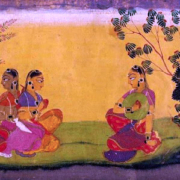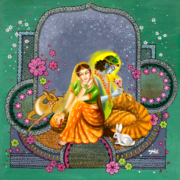How to Chant Mantras? – Part three
By Mahanidhi Swami
Determination, sincerity and devotion in mantra chanting will definitely bring perfection. Iskcon’s Deity worship manual also encourages correct posture along with manasika or silent japa chanting:
“Japa refers to the silent chanting of the Deity mula mantras, and the Gayatri mantras given by the spiritual master. Try to realize that the mantra is nondifferent from the Deity being worshiped. Sit properly on an asana, perform acamana, and cover the right hand with the upper cloth while chanting. The counting of mantras chanted with the fingers should not be exposed to view.” (Pancha Pradipa)
One will never attain the goal of life by worldly intelligence. By increasing the quality of the chanting, bhakti will enter the heart and carry one to the lotus feet of Giridhari. The only purpose of chanting these mantras is to develop pure love for Krishna. Chanting Gayatri is a powerful form of meditation that yields great results when done with sincerity and seriousness.
Srila Visvanatha Cakravartipada explains how even premamayi Srimati Radharani performs intense meditation upon Her beloved after offering prayers to Her Ishta-Devata:
“’If it is not false when people say, “Gandharvika and Giridhari are eternally one soul,” then please O Giridhari! In order to make this half of our soul happy, kindly appear now right here before My eyes!’
“Praying thus, Srimati Radhika then closed Her eyes, and began to meditate upon the beloved of Her soul, Sri Giridhari. Shutting off all the activities of Her senses just like a yogini, Radhika sat motionless while totally fixed in an unbreakable condition of silence.” (Prema Samputa)
All Vaisnavas who take initiation (mantra-diksa) are duty bound to chant their diksa mantras purely without offense daily for their entire lives. Such daily performance of religious rites is called ahnika. The mantras given by the guru may vary, but they usually include the Guru-mantra/gayatri, Gaura & Pancha Tattva m/g, Gopala-mantra, Kama-gayatri, Radha m/g, Panca-tattva mantra, and the Hare Krishna maha-mantra. Conceiving these mantras to be the form of Bhagavan, one should chant them with great faith, love and affection. These mantras are not ordinary; they are completely transcendental and full of unlimited spiritual power.
Before chanting one should bathe, apply tilaka, dress in clean cloth, tie the sikha, and sit on a pure asana. Diksa mantras should be chanted in a quiet, sanctified and peaceful place, ideally in view of the temple Deities or one’s personal Thakuraji.
One can only imagine how quiet and peaceful Vrndavana must have been five hundred years ago during the time of Sri Rupa and Sanatana Gosvami. Still the Gosvamis chose the most secluded places to concentrate on their chanting and lila smarana. In Gokula, Srila Sanatana Gosvami did bhajana in a cave fifteen feet underground. Raghava Gosvami stayed in a cave at Govardhana. And in Unchagoan, Narayana Bhatta Gosvami had a bhajana kutira twenty feet underground. These acaryas show the importance of a “distraction free enviroment” for proper concentration in bhajana.
In the absence of caves for chanting, some devotees today wear earplugs or sound headphones to block out distracting noises while chanting. Using such devices to create a quiet, distraction free environment will definitely improve the quality of one’s chanting. If one tries this technique he will realize the inner meaning of the phrase “silence is golden.” Personally, we often use such headphones while chanting and find them very helpful.
One should try to always chant near Thakuraji or Tulasi Maharani. Alternative places prescribed in sastras include simply facing east, or sitting beside or standing waist deep in a sacred river such as the Yamuna or Ganga. Also sitting beside the ocean or on a mountaintop are auspicious places to chant mantras.
Mantra benefits vary depending on the chanting location: “Chanting diksa mantras on one’s personal purified asana yield one time the benefit; chanting outside yields 1,000 times the benefit; chanting in a river yields 100,000 times the benefit; chanting in front of Thakuraji or the Deities gives unlimited benefit.” (Linga Purana)
“Gayatri japa done in a tulasi garden, in a goshalla, on a temple grounds, or in the presence of the guru very easily controls the mind, brings perfection and spiritual joy.” (Tantrasara)
One should not chant Gayatri in a moving vehicle, on a bed, or with one’s back to a temple, fire, peepul tree (ashvatta vrksha), or a body of water. After selecting the proper time and place, one should sanctify the mind and consciousness. This is done by performing acamana, bhuta-suddhi, and by begging for the mercy of Sri Guru and other personal guardians of devotion.
Bhuta-suddhi will be described in the next article.
(Excerpt from Gayatri Mahima Madhuri by Mahanidhi Swami)
Asana and Mantra Phala ki jai!
Jai Jai Sri Radhe!






Leave a Reply
Want to join the discussion?Feel free to contribute!